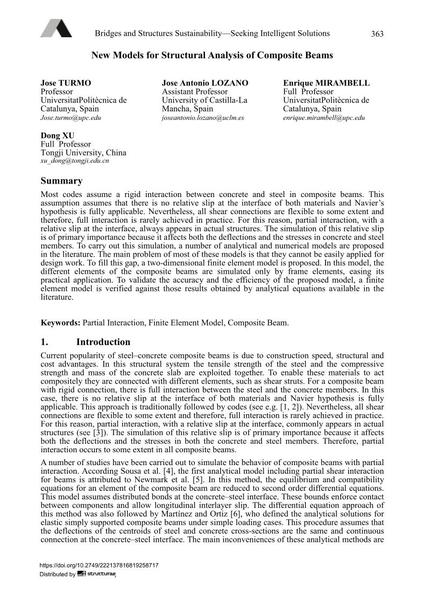New Models for Structural Analysis of Composite Beams

|
|
|||||||||||
Bibliografische Angaben
| Autor(en): |
José Turmo
Dong Xu Jose Antonio Lozano Enrique Mirambell |
||||
|---|---|---|---|---|---|
| Medium: | Tagungsbeitrag | ||||
| Sprache(n): | Englisch | ||||
| Tagung: | IABSE Conference: Bridges and Structures Sustainability - Seeking Intelligent Solutions, Guangzhou, China, 8-11 May 2016 | ||||
| Veröffentlicht in: | IABSE Conference, Guangzhou, China, 8 – 11 May 2016 | ||||
|
|||||
| Seite(n): | 363-370 | ||||
| Anzahl der Seiten (im PDF): | 8 | ||||
| Jahr: | 2016 | ||||
| DOI: | 10.2749/222137816819258717 | ||||
| Abstrakt: |
Most codes assume a rigid interaction between concrete and steel in composite beams. This assumption assumes that there is no relative slip at the interface of both materials and Navier’s hypothesis is fully applicable. Nevertheless, all shear connections are flexible to some extent and therefore, full interaction is rarely achieved in practice. For this reason, partial interaction, with a relative slip at the interface, always appears in actual structures. The simulation of this relative slip is of primary importance because it affects both the deflections and the stresses in concrete and steel members. To carry out this simulation, a number of analytical and numerical models are proposed in the literature. The main problem of most of these models is that they cannot be easily applied for design work. To fill this gap, a two-dimensional finite element model is proposed. In this model, the different elements of the composite beams are simulated only by frame elements, easing its practical application. To validate the accuracy and the efficiency of the proposed model, a finite element model is verified against those results obtained by analytical equations available in the literature. |
||||
| Stichwörter: |
Verbundträger Finite-Elemente-Modell
|
||||
